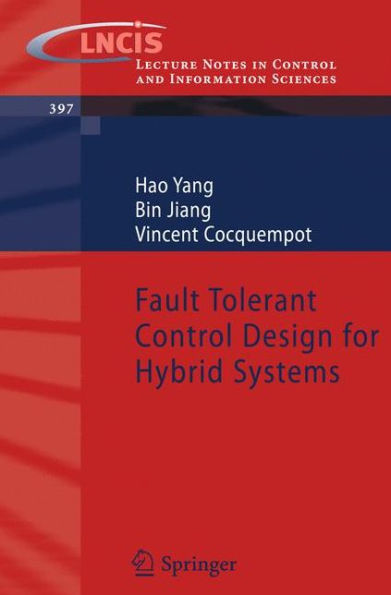Fault Tolerant Control Design for Hybrid Systems
Hybridsystems(HS)aredynamicalsystemsthatinvolvetheinteractionofconti- ousanddiscretedynamics.ThestudyofHSismotivatedbythefundamentally- bridnatureofmanyreallifeapplications.Overthelastdecade,signi?cantprogress has taken place in modeling and simulation, veri?cation, stability and controller synthesisforHS. Faultsinautomatedprocessesoftencauseundesiredreactionsandshut-downof a controlledplant,andtheconsequencescouldbedamagetotechnicalpartsofthe plant or to its environment. Fault diagnosis (FD) and fault tolerant control (FTC) arehighlyrequiredforsafetypurpose,andaimatguaranteeingcertainsystemp-
formances and/or properties to be maintained in spite of faults. In the past more than30years,fruitfultheoreticalresultsonFDandFTChavebeenreportedforv- iouslinearandnonlinearsystemswithmanysuccessfulengineeringapplicationsin practicalsystems. FD problem for HS has attracted some attentions. However, to the best of the authors' knowledge, until now, the FTC issue for HS has not yet been intensively studied. FTC method for HS deserves further investigations due to its academic meaningaswellaspracticalone. 1. Motivationfromacademicresearch Itiswellknownthatthestabilityandsomespeci?cationsofHScanbeachieved underquite rigorousconditions.Most of existing results are devotedto off-line analysisanddesign,suchthattheHSworkswellaswhatitisexpected.However, faultsmayabruptlychangesystembehavior,FTCstrategiesmustbeapplied- line,notonlytokeepthestabilitybutalsotomaintainsomespeci?cationsofthe
HSinpresenceoffaults.Thisresultsinagreattheoreticalchallenge,sincemany classicalFTCmethodsfornon-hybridsystemscannotbeeasilyextendedtoHS. FTCtheoryforHSneedstobedeveloped. VIII Preface 2. Motivationfrompracticalapplications
Manypracticalsystemshavetobemodeledbyhybridmodels,e.g.chemicalp- cesses,switchedRLCcircuits,intelligenttransportationsystems,etc.Thesafety andreliabilityofthesesystemsareneeded,andFTCtechniquesforHSarehighly required. The HS
considered in this book consists of a series of continuous modes and a switching logic. Switching from one mode to another is due to a switching law generated from the switching logic. Faulty behaviors of HS are investigated s- tematically.Two main kindsof faults are considered:Continuous faults that affect continuous modes; Discrete faults that affect the desired switching. In these two faultycases,theFTCdesignhastwomainobjectivesasfollows: 1)
maintainthecontinuousperformancesincludingvariousstabilities (e.g.L- punovstability,asymptoticalstability andinput-to-statestability)oftheoriginand theoutputtracking/regulationbehaviorsalongthetrajectoriesofHS. 2) maintain the discrete speci?cations that have to be followed by HS, e.g. a desiredswitchingsequence.
1101634360
formances and/or properties to be maintained in spite of faults. In the past more than30years,fruitfultheoreticalresultsonFDandFTChavebeenreportedforv- iouslinearandnonlinearsystemswithmanysuccessfulengineeringapplicationsin practicalsystems. FD problem for HS has attracted some attentions. However, to the best of the authors' knowledge, until now, the FTC issue for HS has not yet been intensively studied. FTC method for HS deserves further investigations due to its academic meaningaswellaspracticalone. 1. Motivationfromacademicresearch Itiswellknownthatthestabilityandsomespeci?cationsofHScanbeachieved underquite rigorousconditions.Most of existing results are devotedto off-line analysisanddesign,suchthattheHSworkswellaswhatitisexpected.However, faultsmayabruptlychangesystembehavior,FTCstrategiesmustbeapplied- line,notonlytokeepthestabilitybutalsotomaintainsomespeci?cationsofthe
HSinpresenceoffaults.Thisresultsinagreattheoreticalchallenge,sincemany classicalFTCmethodsfornon-hybridsystemscannotbeeasilyextendedtoHS. FTCtheoryforHSneedstobedeveloped. VIII Preface 2. Motivationfrompracticalapplications
Manypracticalsystemshavetobemodeledbyhybridmodels,e.g.chemicalp- cesses,switchedRLCcircuits,intelligenttransportationsystems,etc.Thesafety andreliabilityofthesesystemsareneeded,andFTCtechniquesforHSarehighly required. The HS
considered in this book consists of a series of continuous modes and a switching logic. Switching from one mode to another is due to a switching law generated from the switching logic. Faulty behaviors of HS are investigated s- tematically.Two main kindsof faults are considered:Continuous faults that affect continuous modes; Discrete faults that affect the desired switching. In these two faultycases,theFTCdesignhastwomainobjectivesasfollows: 1)
maintainthecontinuousperformancesincludingvariousstabilities (e.g.L- punovstability,asymptoticalstability andinput-to-statestability)oftheoriginand theoutputtracking/regulationbehaviorsalongthetrajectoriesofHS. 2) maintain the discrete speci?cations that have to be followed by HS, e.g. a desiredswitchingsequence.
Fault Tolerant Control Design for Hybrid Systems
Hybridsystems(HS)aredynamicalsystemsthatinvolvetheinteractionofconti- ousanddiscretedynamics.ThestudyofHSismotivatedbythefundamentally- bridnatureofmanyreallifeapplications.Overthelastdecade,signi?cantprogress has taken place in modeling and simulation, veri?cation, stability and controller synthesisforHS. Faultsinautomatedprocessesoftencauseundesiredreactionsandshut-downof a controlledplant,andtheconsequencescouldbedamagetotechnicalpartsofthe plant or to its environment. Fault diagnosis (FD) and fault tolerant control (FTC) arehighlyrequiredforsafetypurpose,andaimatguaranteeingcertainsystemp-
formances and/or properties to be maintained in spite of faults. In the past more than30years,fruitfultheoreticalresultsonFDandFTChavebeenreportedforv- iouslinearandnonlinearsystemswithmanysuccessfulengineeringapplicationsin practicalsystems. FD problem for HS has attracted some attentions. However, to the best of the authors' knowledge, until now, the FTC issue for HS has not yet been intensively studied. FTC method for HS deserves further investigations due to its academic meaningaswellaspracticalone. 1. Motivationfromacademicresearch Itiswellknownthatthestabilityandsomespeci?cationsofHScanbeachieved underquite rigorousconditions.Most of existing results are devotedto off-line analysisanddesign,suchthattheHSworkswellaswhatitisexpected.However, faultsmayabruptlychangesystembehavior,FTCstrategiesmustbeapplied- line,notonlytokeepthestabilitybutalsotomaintainsomespeci?cationsofthe
HSinpresenceoffaults.Thisresultsinagreattheoreticalchallenge,sincemany classicalFTCmethodsfornon-hybridsystemscannotbeeasilyextendedtoHS. FTCtheoryforHSneedstobedeveloped. VIII Preface 2. Motivationfrompracticalapplications
Manypracticalsystemshavetobemodeledbyhybridmodels,e.g.chemicalp- cesses,switchedRLCcircuits,intelligenttransportationsystems,etc.Thesafety andreliabilityofthesesystemsareneeded,andFTCtechniquesforHSarehighly required. The HS
considered in this book consists of a series of continuous modes and a switching logic. Switching from one mode to another is due to a switching law generated from the switching logic. Faulty behaviors of HS are investigated s- tematically.Two main kindsof faults are considered:Continuous faults that affect continuous modes; Discrete faults that affect the desired switching. In these two faultycases,theFTCdesignhastwomainobjectivesasfollows: 1)
maintainthecontinuousperformancesincludingvariousstabilities (e.g.L- punovstability,asymptoticalstability andinput-to-statestability)oftheoriginand theoutputtracking/regulationbehaviorsalongthetrajectoriesofHS. 2) maintain the discrete speci?cations that have to be followed by HS, e.g. a desiredswitchingsequence.
formances and/or properties to be maintained in spite of faults. In the past more than30years,fruitfultheoreticalresultsonFDandFTChavebeenreportedforv- iouslinearandnonlinearsystemswithmanysuccessfulengineeringapplicationsin practicalsystems. FD problem for HS has attracted some attentions. However, to the best of the authors' knowledge, until now, the FTC issue for HS has not yet been intensively studied. FTC method for HS deserves further investigations due to its academic meaningaswellaspracticalone. 1. Motivationfromacademicresearch Itiswellknownthatthestabilityandsomespeci?cationsofHScanbeachieved underquite rigorousconditions.Most of existing results are devotedto off-line analysisanddesign,suchthattheHSworkswellaswhatitisexpected.However, faultsmayabruptlychangesystembehavior,FTCstrategiesmustbeapplied- line,notonlytokeepthestabilitybutalsotomaintainsomespeci?cationsofthe
HSinpresenceoffaults.Thisresultsinagreattheoreticalchallenge,sincemany classicalFTCmethodsfornon-hybridsystemscannotbeeasilyextendedtoHS. FTCtheoryforHSneedstobedeveloped. VIII Preface 2. Motivationfrompracticalapplications
Manypracticalsystemshavetobemodeledbyhybridmodels,e.g.chemicalp- cesses,switchedRLCcircuits,intelligenttransportationsystems,etc.Thesafety andreliabilityofthesesystemsareneeded,andFTCtechniquesforHSarehighly required. The HS
considered in this book consists of a series of continuous modes and a switching logic. Switching from one mode to another is due to a switching law generated from the switching logic. Faulty behaviors of HS are investigated s- tematically.Two main kindsof faults are considered:Continuous faults that affect continuous modes; Discrete faults that affect the desired switching. In these two faultycases,theFTCdesignhastwomainobjectivesasfollows: 1)
maintainthecontinuousperformancesincludingvariousstabilities (e.g.L- punovstability,asymptoticalstability andinput-to-statestability)oftheoriginand theoutputtracking/regulationbehaviorsalongthetrajectoriesofHS. 2) maintain the discrete speci?cations that have to be followed by HS, e.g. a desiredswitchingsequence.
109.99
In Stock
5
1

Fault Tolerant Control Design for Hybrid Systems
192
Fault Tolerant Control Design for Hybrid Systems
192Paperback(2010)
$109.99
109.99
In Stock

Product Details
| ISBN-13: | 9783642106804 |
|---|---|
| Publisher: | Springer Berlin Heidelberg |
| Publication date: | 01/15/2010 |
| Series: | Lecture Notes in Control and Information Sciences , #397 |
| Edition description: | 2010 |
| Pages: | 192 |
| Product dimensions: | 6.10(w) x 9.10(h) x 0.70(d) |
From the B&N Reads Blog
